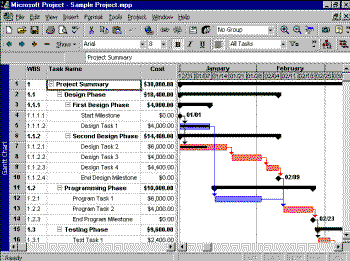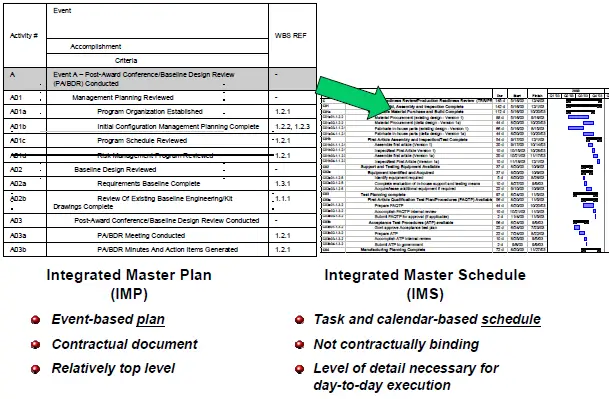The Integrated Master Schedule (IMS) is a time-based schedule containing the networked, detailed tasks necessary to ensure successful program/contract execution. The IMS is traceable to the Integrated Master Plan (IMP), Work Breakdown Structure (WBS), Statement of Work (SOW), Contractor Performance Report (CPR), and Earn Value Management system (EVMS).
Definition: The Integrated Master Schedule (IMS) is a time-based schedule containing the networked, detailed tasks necessary to ensure successful program/contract execution.
What is the Integrated Master Schedule Used For
The IMS is used to verify the attainability contract objectives, evaluate progress toward meeting program objectives, and integrate the program schedule activities with all related components. The Program Manager (PM) develops an IMS on all cost or incentive contracts, subcontracts, Government Interagency Acquisition work agreements, and other agreements valued at or over $20 million. [1]
The IMS utilizes Critical Path network management techniques to optimize the relationship of critical activities. It uses the same (3) three; Events, Accomplishments, and Criteria to show network relationships; as IMP.

The 4 Steps to Developing an Integrated Master Schedule (IMS): [1]
- Step 1: Develop the Integrated Master Plan (IMP)
- Step 2: Develop the Work Breakdown Structure (WBS) based on the overall system’s Physical Architecture, identifying all of the major systems and subsystems down to a configuration item level (CI)
- Step 3: Defined configuration item level in terms of calendar time and resources to complete
- Step 4: Place developed system time and resources into scheduling software (see Schedule Development)
Guide: DoD Integrated Master Plan & Integrated Master Schedule Preparation & User Guide
IMS Contract Data Requirements List (CDRL)
Data Item Description DI-MGMT-81661 “Integrated Program Management Report (IPMR
Best Practices in Developing Integrated Master Schedule (IMS)
Here is a list of the best techniques I’ve learned from developing multiple IMS.
- Make sure to capture all tasks
- Putting all tasks in the proper order
- Put resources behind each activity
- Figure out how long each activity will take
- Check that the schedule can be followed from both sides to side and up and down
- Make sure that the critical path is correct
- Make sure the total float is reasonable
- Put together a schedule Risk Analysis
- Use actual progress and logic to change the schedule
- Keep a baseline schedule
How the Integrated Master Plan (IMP) relates to the Integrated Master Schedule (IMS)
The Integrated Master Plan (IMP) and Integrated Master Schedule (IMS) are linked together and show that a program is adequately planned and has the potential to achieve its goals and objectives within a program’s schedule and cost constraints. The IMP and IMS are valuable tools a PM can use in preparing for a Request for Proposal (RFP) and Source Selection. It can be the basis of an offeror’s proposal and evaluation criteria.
The IMP and IMS are Program Management tools for program personnel and stakeholders to provide oversight of acquisition programs. They provide a systematic approach to program planning, scheduling, and execution.

Integrated Master Plan (IMP)
The Integrated Master Plan (IMP) is an event-based, top-level plan consisting of a hierarchy of Program Events. Each event is decomposed into specific accomplishments, and each specific accomplishment is decomposed into specific Criteria. The IMP is ultimately used to develop a time-based Integrated Master Schedule (IMS) to show a networked, multi-layered schedule showing all the detailed tasks required to accomplish the work effort contained in the IMP. The IMP and IMS are related to the Work Breakdown Structure (WBS). The IMP provides a Program Manager (PM) with systematic planning, scheduling, and execution approach.
AcqNotes Tutorial
AcqLinks and References:
- [1] Defense Acquisition Guidebook (DAG)
- Guide: DoD Integrated Master Plan and Integrated Master Schedule Preparation and User Guide
Updated: 6/9/2023
Rank: G1.1
